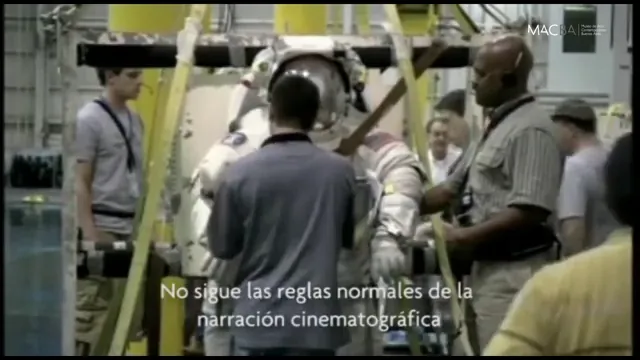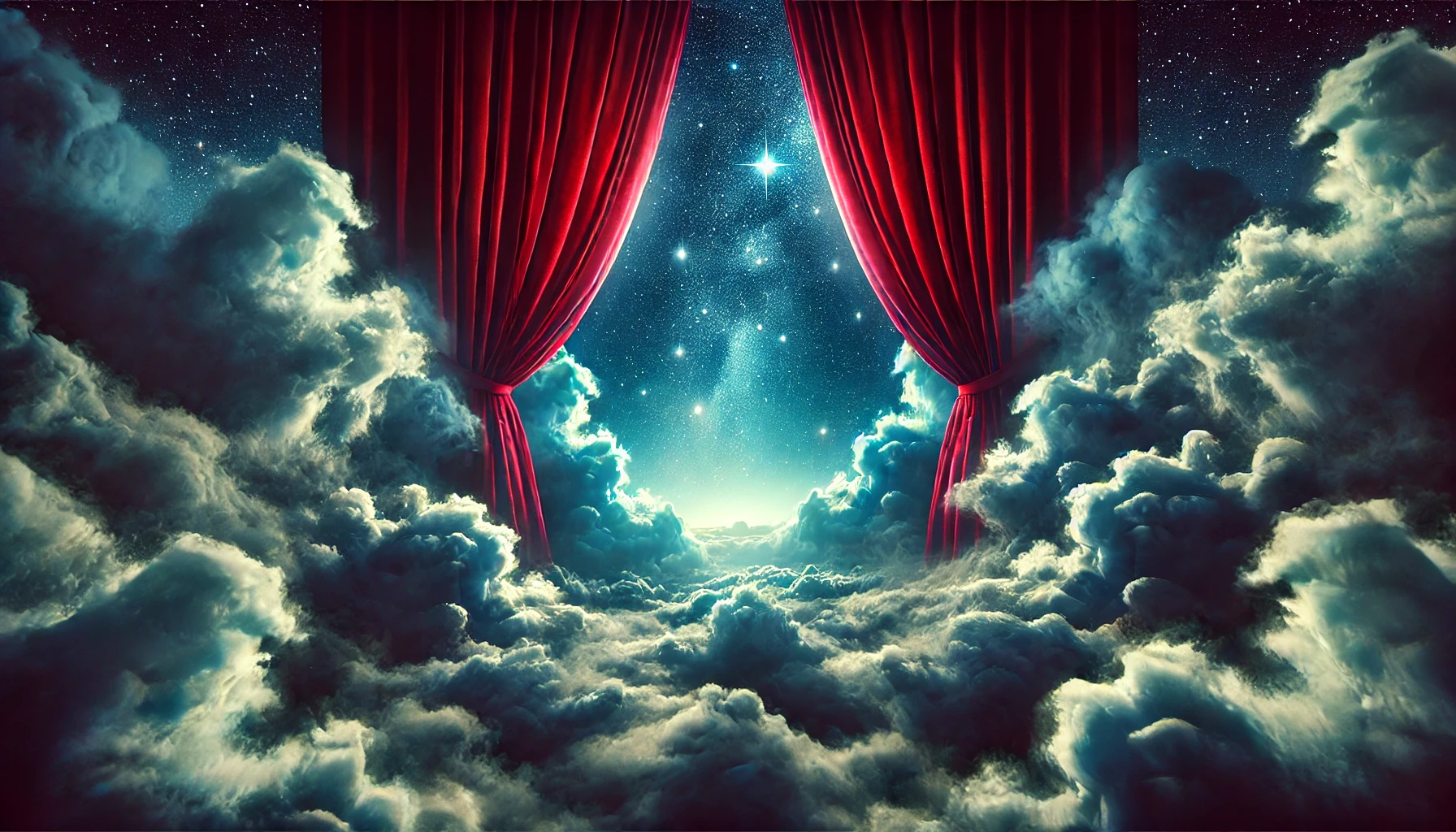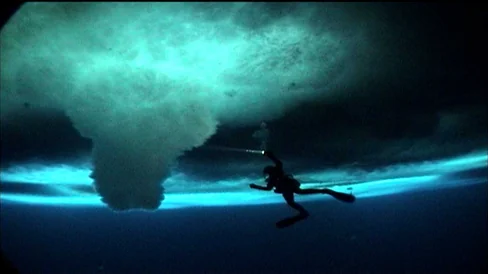🎯 Quick Overview
Trailer
- Director: Werner Herzog
- Genre: Documentary, Fantasy, Sci-Fi
- Release year: 2005
- Runtime (length): 1h 21min
- IMDb rating: 6.1/10 (3.0K votes)
- Rotten Tomatoes: 58%
😅 Plot Summary – Badly Explained
Aliens who were bad at building Earth malls narrate their history while humans use old NASA footage and underwater shots to find a new icy planet after Earth goes bad.
🍿 The Wild Blue Yonder: Detailed Plot Synopsis
A Distant Alien Perspective
The film is primarily narrated by an alien character, portrayed by Brad Dourif, who addresses the camera directly. He recounts the history of his dying home planet in the Andromeda galaxy and his species’ journey to Earth centuries ago. Their attempt to colonize Earth and build a new society ultimately failed, leaving behind abandoned structures in desolate locations. The alien reflects on the limitations and failures of his people, contrasting them with humanity’s eventual fate.

Humanity’s Search for a New Home
As Earth faces its own environmental decline and potential man-made demise, a group of human astronauts embarks on a desperate mission. Utilizing complex mathematical theories involving ‘wormholes,’ they aim to travel vast cosmic distances in search of an inhabitable planet. The film intersperses the alien’s narrative with extensive archival footage, including scenes of NASA space missions and scientific lectures, presenting these real-world images as the visual representation of the human space journey.

⚠️ Spoilers and Ending Explained
🎬 Cast & Characters
- The Alien (Brad Dourif): The primary narrator and extraterrestrial who recounts his species’ failed colonization of Earth and humanity’s own search for a new home.
- Astronaut Commander (Donald Williams): The leader of the human space mission attempting to find a new planet for humanity.
- Astronaut Physician (Ellen Baker): A member of the human space mission crew serving in a medical capacity.
- Astronaut Plasma Physicist (Franklin Chang-Diaz): A scientist who provides explanations related to the complex physics of space travel.
- Mathematician (Roger Diehl): A scientific expert whose commentary adds a layer of theoretical explanation to the film.
- Mathematician (Ted Sweetser): A scientific expert who contributes to the film’s discussion of complex scientific ideas.
💬 Memorable Quotes
- The Alien: “You know, our great-great-great-great-great-great-great-great grandfathers were fine scientists, but the journey was long and boring and when we got here, hundreds of hundreds and hundreds and hundreda and hundreds of years later, those of us who arrived here just… sucked.” – Reflecting on the arduous, multi-generational journey his ancestors undertook from their dying planet and the disappointing state of the aliens who finally arrived on Earth.
- The Alien: “World War One, World War Two, Marilyn Monroe, Elvis Presley…” – Listing the key events and figures he identifies as the defining moments of human history during his time on Earth, highlighting their perceived absurdity from an alien perspective.
- The Alien: “We attempted to build our capital, a magnificent city with monuments… and a shopping mall… but it failed. Nobody came.” – Describing the aliens’ unsuccessful efforts to establish a new civilization on Earth, contrasting grand ambitions with a mundane failure culminating in an abandoned, half-built city.
- The Alien: “I even worked for the CIA for a while… it was boring.” – Revealing a surprising and anticlimactic detail about his integration into human society, underscoring his disillusioned view of Earth and human endeavors.
- The Alien: “You’re probably sitting there thinking, ‘This guy sucks. I can’t believe what I’m hearing.’ Well… you’re probably right. Aliens suck.” – Directly addressing the viewer with cynical self-awareness, echoing a recurring sentiment and reinforcing the film’s unconventional tone.
💰Box Office
- Budget: Unknown
- Domestic Gross: Unknown
- Worldwide Gross: $6,970
💥 The Wild Blue Yonder Reviews
Personal Review
Wow, ‘The Wild Blue Yonder’ is… something else. I went in expecting a weird Herzog sci-fi, and that’s exactly what I got, but it’s so much weirder than I imagined. Brad Dourif is absolutely captivating as the alien narrator; his performance alone makes the film worth watching, even when the story feels like it’s drifting. The use of real NASA footage and those stunning, eerie underwater scenes from Antarctica is just hypnotic. They create this incredible sense of both wonder and isolation. I found myself completely lost in the visuals, especially when paired with the unusual, haunting soundtrack. Granted, the pacing is *glacial* at times, and the ‘plot’ is more of a philosophical rambling strung across disparate images. It feels less like a traditional movie and more like a fever dream about space, despair, and human (and alien) failure. It stuck with me long after it ended, making me think about our place in the universe and our relationship with our own planet.
- Who would enjoy:
- “Fans of Werner Herzog’s unique directorial style”
- “Viewers interested in experimental or philosophical science fiction”
- “Those who appreciate found footage and mixed-media filmmaking”
- “Audiences open to slow-paced, meditative cinematic experiences”
- “Individuals interested in themes of environmentalism, human ambition, and cosmic perspective”
- Content warnings ⚠:
- “Slow/Experimental Pacing”
- “Unconventional Narrative Structure”
- “Disjointed Imagery and Sound”
- “Philosophical Themes (Potential for existential reflection)”
- “Environmental/Apocalyptic Themes”
Professional Reviews
- User Review on IMDb: “This isn’t your average sci-fi epic; it’s more like visual poetry that’s both fascinating and, at times, challenging. The story works surprisingly well, using found footage to build a unique atmosphere. Brad Dourif’s narration is key, holding your attention even through longer, quieter sequences. It’s definitely not for everyone, and moments under the ice can get repetitive, but it’s a daring and genuinely engaging experience.
- User Review on IMDb: “Herzog delivers an intentional failure as a conventional sci-fi film, and that’s precisely the point. It’s a meta-textual joke, a commentary on human nature and the absurdity of expecting space travel to solve our problems. The tedious stock footage and the alien admitting they “suck” highlight this. It’s a strange, forgettable plot but an unforgettable experience, though definitely best for Herzog fans or those into philosophical sci-fi.
Audience Reactions
Viewers were captivated or repelled by the unique blend of real footage and fictional narration.: Many found the underwater Antarctic footage and the overall visual style to be beautiful and hypnotic, while Brad Dourif’s performance was often singled out as compelling or at least fascinatingly strange.
Overall Consensus: A highly divisive, unconventional film praised by some as a poetic, thought-provoking art piece and dismissed by others as boring, pretentious, and cheaply assembled using stock footage.
Awards
- Venice Film Festival (FIPRESCI Prize (Parallel Sections))- 2005
🛠️ Behind the Scenes
- “Much of the film’s visuals consist of stock footage, including material from NASA space shuttle missions (reportedly available for free use by American taxpayers, according to Herzog) and stunning underwater footage shot by cinematographer Henry Kaiser beneath the Antarctic ice.”
- “The sequences depicting the alien planet are primarily composed of underwater footage shot under the ice floe in McMurdo Sound, Antarctica, repurposed to resemble an alien environment with a ‘sky made of ice’.”
- “Brad Dourif, the only actor appearing on screen for the main narrative, filmed his segments in the Salton Sea area of California, including the ghost town of Niland, giving his character a desolate and grounded setting.”
- “Werner Herzog has described Brad Dourif’s performance as representing his ‘face, my appearance, my voice and my thought’ for the film.”
- “The film features interviews with real scientists and mathematicians, including Franklin Chang-Diaz and Roger Diehl, discussing complex topics like space travel and chaotic dynamics, grounding the speculative narrative in scientific reality, albeit sometimes presented in a way that makes them seem eccentric.”
🖥️ How to Watch The Wild Blue Yonder?
Werner Herzog’s experimental film ‘The Wild Blue Yonder’ is available for streaming on platforms like Kanopy (via library access) and Tubi. It can also be rented or purchased digitally through services like Prime Video and Apple TV, or found on DVD/Blu-ray via retailers such as Amazon.

🎥 Similar Movies
If you enjoyed The Wild Blue Yonder, you might like these similar films:
- Sans Soleil (1983): Uses a reflective, philosophical voiceover narration over diverse, often disconnected documentary footage and found images to explore themes of memory, time, and place across the globe, similar to Herzog’s essayistic approach.
- Koyaanisqatsi (1982): A non-narrative film that relies entirely on stunning visuals (often time-lapse) and a powerful score to create a ‘visual essay’ on humanity’s relationship with technology and the environment, sharing a similar unconventional, philosophical, and visually driven style.
- Solaris (1972): Andrei Tarkovsky’s meditative and philosophical science fiction film exploring themes of memory, consciousness, and humanity’s limitations in understanding the universe during a space mission, offering a deeply thoughtful counterpoint to typical sci-fi.
- Primer (2004): An acclaimed independent science fiction film from the same era known for its complex, realistic portrayal of scientific discovery and its unconventional narrative structure, appealing to audiences who appreciate cerebral and low-budget sci-fi experimentation.
- Last and First Men (2020): A visual and sonic essay featuring a narrator from two billion years in the future recounting the history and fate of humanity over stark, breathtaking visuals of brutalist monuments, sharing a similar blend of philosophical voiceover and striking imagery.
🛒 The Wild Blue Yonder Related Products
- Werner Herzog: The Collection: Explore the diverse and challenging filmography of director Werner Herzog, known for blurring lines between documentary and fiction and seeking ‘ecstatic truth’.
- NASA Space Shuttle Missions Documentary Collection: A collection of documentary footage and films chronicling the actual NASA Space Shuttle program, showcasing the real-life moments used and recontextualized in the movie.
- Endurance: Shackleton’s Incredible Voyage: Alfred Lansing’s gripping account of Ernest Shackleton’s ill-fated Antarctic expedition and the crew’s miraculous survival against impossible odds in a harsh, frozen environment.
- Elite Dangerous (Digital Download): An epic space flight simulation game where players explore a realistic 1:1 scale open-world representation of the Milky Way galaxy. Features include trading, combat, mining, and exploration.
🎧 Soundtrack
The Wild Blue Yonder features a captivating soundtrack that enhances the movie’s atmosphere and emotional impact. Here are some notable tracks:
- “Bad News from Outer Space” – performed by Ernst Reijseger
- “Original Score” – performed by Ernst Reijseger, Mola Sylla, and the Sardinian choir
You can find the complete soundtrack on Amazon Music and Apple Music.
🤨 FAQ
While it extensively uses real documentary and archival footage (from NASA, scientific interviews, and underwater expeditions), ‘The Wild Blue Yonder’ is officially categorized as a science fiction fantasy film. It weaves these real images into a fictional narrative told from the perspective of an alien.
The film heavily utilizes archival footage from NASA space shuttle missions and extensive underwater cinematography shot under the Antarctic ice. It also includes filmed segments of scientists discussing theoretical physics and original scenes featuring actor Brad Dourif.
The main character, the alien narrator, is played by acclaimed actor Brad Dourif, known for roles in ‘One Flew Over the Cuckoo’s Nest,’ ‘Child’s Play,’ and ‘The Lord of the Rings.’
The film features a unique and often challenging soundtrack by Ernst Reijseger, incorporating elements like Sardinian folk singing (specifically a five-voiced male choir), African vocals by Mola Sylla, and cello. The music is noted for being atmospheric, experimental, and sometimes described as jarring or hypnotic.
While not directly related in plot, ‘The Wild Blue Yonder’ utilizes some of the stunning underwater footage shot in Antarctica that Werner Herzog would later feature more extensively in his documentary ‘Encounters at the End of the World.’ Both films share some visual material and Herzog’s thematic interests in extreme environments.
🔥 Bonus Content
Relive the moment the Doctor and Donna realise they aren’t alone in ‘Wild Blue Yonder’… #DoctorWho
Okay, buckle up! This scene where the Doctor and Donna realize they are *not* alone in ‘Wild Blue Yonder’ gave me chills – definitely a moment you have to see again!
Watch the moment the Doctor and Donna (?) make their escape in the TARDIS! 💥 #DoctorWho
Curious how they got out of that sticky situation? Relive the pulse-pounding escape in the TARDIS from ‘Wild Blue Yonder’ – the TARDIS always comes through!
“Hello, me old soldier!” The Doctor reunites with an old friend in ‘Wild Blue Yonder’❤️❤️ #DoctorWho
Oh, this reunion! The Doctor meeting an old friend in ‘Wild Blue Yonder’ is just pure joy and a really heartwarming (and a little heartbreaking) moment you won’t want to miss.
✨ Rate
There are no reviews yet. Be the first one to write one.





